 |
This photo illustrates the preparation of the fuel pellets
before they are loaded into the individual fuel rods as shown below. |
| Photo courtesy AECL |
|
| There are 380, 390 or 480 horizontal fuel channels in each
CANDU. The number of channels is related to the Megawatt output of the reactor. In India,
AECL- and Indian-designed reactors each have 306 fuel channels. Each
fuel channel consists of an inner pressure tube, which contains the fuel bundles and the
heavy water primary coolant, and an outer calandria tube.
The tubes are concentric, and the gap between them (8-9 mm) is filled
with a slow purge of carbon dioxide.
The calandria tube keeps the heavy water moderator (<70 C) away from
the pressure tube (~310 C). The moderator (in the calandria vessel) is essentially at
atmospheric pressure (the head of heavy water plus a cover gas pressure). |
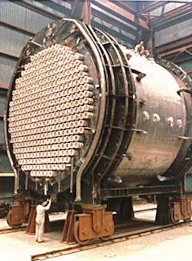 |
| Data courtesy Morgan Brown of AECL |
Photo courtesy AECL |
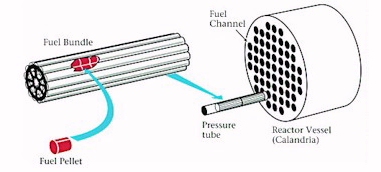 |
This graphic shows how fuel pellets are loaded into fuel
rods in a fuel bundle (fuel assembly). Then shown is the location of the fuel bundle
within the pressure tube and calandria. |
| Photo courtesy AECL |
|
| This graphic illustrates how fueling machines load the fuel bundles
into the reactor and how a defueling machine removes the spent bundles. The spent fuel is
pushed by one fueling machine into another fuelling machine attached to the same pressure
tube. After the fueling machines are detached from a channel (after the end plugs are
refitted), the receiving machine offloads the spent bundles to the cooling pond. |
 |
|
Graphic courtesy AECL |
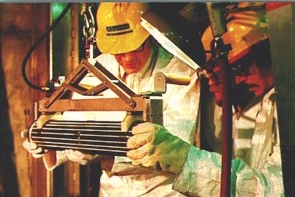 |
This photo shows the size of the fuel bundle used in the CANDU reactor. |
| Photo courtesy AECL |
|
| As in the PWR, control rods can shut down the reactor. Similar to the
PWR, a bank of shutdown rods, normally held up against gravity and springs by
electro-magnetic clutches, can drop into an unpressurized calandria vessel - they don't
have to be driven in. |
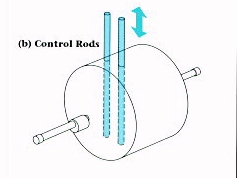 |
|
Graphic courtesy AECL |
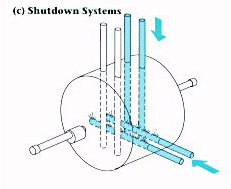 |
A second shutdown system is via gadolinium nitrate liquid "neutron
poison" injection. Both systems operate via separate and independent trip logic. The gadolinium nitrate system function is similar to that of the PWR high
pressure safety injection system or the BWR standby liquid control system. |
| Graphic courtesy AECL |
|






